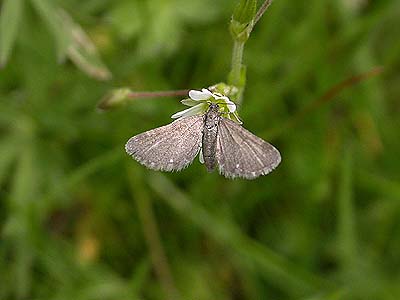

| Eakring Moths 2003 |
| A summary of the year |
| By the end of
2003, this list stood at just over 250 identified species
of moth, but this is believed to be just about 50% of the
total species that the Eakring and Kersall area actually
holds. An array of techniques were employed to
attract/find or trap moths - all equally as productive. Among those recorded during the year were some notable moths. Although not always inspiring to look at, some new moths found this year attain as rare a status here as within Nottinghamshire as a whole. Perhaps the two most exciting new species were Marsh Pug and Phlyctaenia perlucidalis, despite both having rather drab appearences. Phlyctaenia perlucidalis was first recorded in Nottinghamshire from Newstead Abbey in 1991. There have been a few more recent records during the interim period, but the record here still remains an extremely significant one. |
 |
|||
| .... | ||||
| The Marsh Pug
was first found in an area of established meadowland on
Red Hill (late May) before also being found at several
sites in the Eakring Meadows Nature Reserve complex, then
later at Oil Bore Holes in Eakring village. Most of the
adults recorded were females, typically flying low within
grasses searching for the flowers of Field Mouse-ear (Cerastium
arvense) where eggs were noted being laid inside the
flower heads. The Marsh Pug is currently ascribed a Grade
2 listing and it's small size renders it quite
inconspicuous. The only other known site in
Nottinghamshire is the Carr-lands around Misterton in the
very north of the county. Subsequently, the occurrence of
Marsh Pug represents a very important find. Migrant moths were represented by Diamond-back Moth, Silver Y and the spectacular Hummingbird Hawk-moth, which appeared in the area for the second time since 1998. With record numbers invading the UK, hopes were high that it would again be recorded and during the latter part of the Summer it was. Daily checking of patches of Valerian paid dividends and eventually, a succession of records occurred in September, following the first on August 23rd and peaking with three adults in Eakring village on September 15th. Records also came on 8th and 16-19th. There was a clear migration of Hummingbird Hawk-moths through the area during that period, but the Silver Y moth moved through in far greater numbers at the end of August. Many hundreds (and probably thousands) of adults were noted during this time. The much smaller Diamond-back Moth arrived in such substantial numbers around mid-June, as to give it "very common" status after an early migrant was netted along the Kneesall Road on the early date of April 15th. There were few records later in the year, which was surprising after such a Spring influx. With the weather so favourable this year, most species produced much earlier emergences than in 2002. In some cases this was by as much as a month. There were also some partial second broods by certain species. A drive along the area's roads was again often the best way to see how populations were distributed, or where colonies were strongest. Because of habitat destruction, there are some moths whose distribution over the area is now more limited than say 20-30 years ago, but many grass-feeding species are still abundant along roadsides. Of the commoner moths found here, Snout, Silver-ground Carpet and Mother of Pearl were all abundant again and featured heavily on trapping nights. Light-trapping certainly proved to be the most reliable way of catching moths and nocturnal sojourns provided further Grade 3 species including Map-winged Swift, Small Elephant Hawk-moth, Lunar Marbled Brown, Rufous Minor and Small Yellow Underwing. The record of Small Elephant Hawk-moth was a real surprise, as agricultural farmland is hardly renowned as providing ideal habitat for the species, thus making it one of the most exciting moths of the year. The fact that so many graded county species were attracted to simple light-trapping techniques, shows just what valuable results can still be achieved in an age when many suppose such results are already known. |
||||